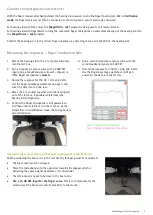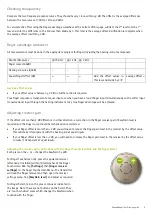
Phonak
Roger™ verification guide
3
Connect the microphone and receivers
With the Roger receiver attached/installed, the hearing aid powered on and the Roger Touchscreen Mic in
Verification
mode
, the Roger receiver must then be connected to the microphone; even if previously connected.
For hearing aids with DAI, ensure the
[Roger/DAI + mic]
program is being used for all measurements.
For hearing aids with RogerDirect, turning the connected Roger microphone on will automatically put the hearing aid into
the
[Roger mic]
program.
Confirm the hearing aid is in the correct Roger program via a listening check or via the LED on the hearing aids.
Measuring the responses
–
Roger Touchscreen Mic
1.
Attach the hearing aid to the 2 cc coupler and place
into the test box.
2.
Run a frequency response curve with a 65dB SPL
input using a broadband signal (speech- shaped, i.e.
ISTS); Roger microphone is
muted.
3.
Record the response for 750 Hz, 1 kHz, and 2 kHz.
Use the Roger advantage worksheet on page 5 and
enter the data into the 2nd row.
4.
Move the 2 cc coupler together with the hearing aid
out of the test box. If possible isolate/cover the
hearing aid microphones.
5.
Confirm the Roger microphone is still powered on
and then unmute it. Place it in the test box. As the
transmitter is in Verification mode, the microphone is
omni directional.
6.
Run a second frequency response curve with the
same broadband signal at 65 dB SPL.
7.
Record the response for 750 Hz, 1 kHz, and 2 kHz.
Use the Roger advantage worksheet on Page 5
and enter the data into the 1st row.
Test 1: Hearing aid in test box
Test 2: Roger microphone in test box
Important notes for verifying with Roger Touchscreen Mic and boom-mic
When positioning the boom-mic in the test box the following must be considered:
•
The foam cover must be removed.
•
Place the microphone with the open slots towards the speaker which is
delivering the speech signal (remember, it is directional.
•
The reference mic needs to be close to the boom-mic.
•
Use a 75 dB SPL input for the Roger curve.
This is to compensate for the
sensitivity of the boom-mic and its proximity to the mouth.














